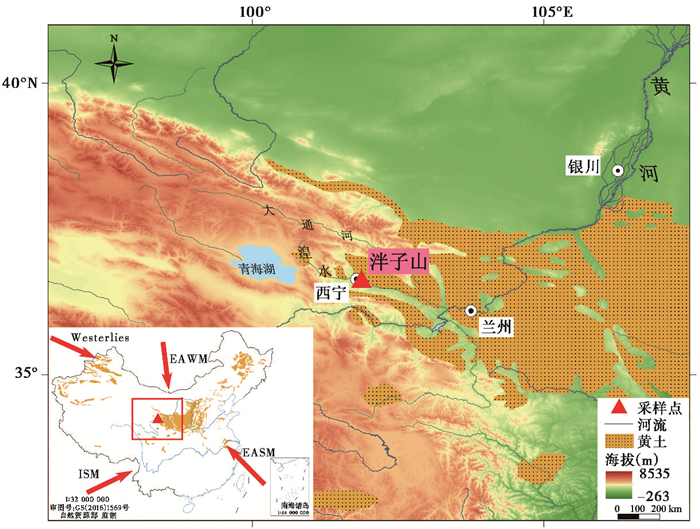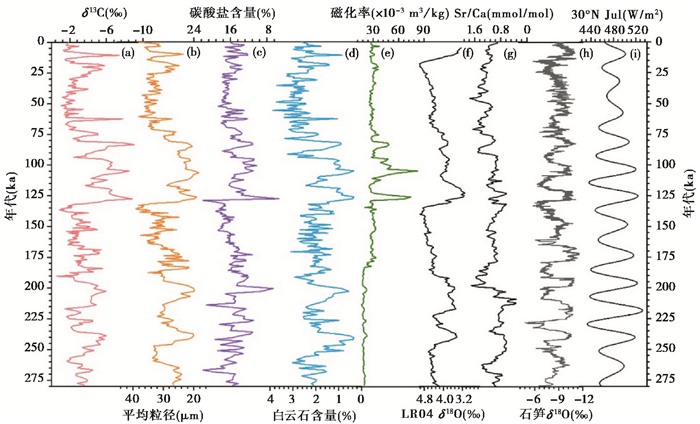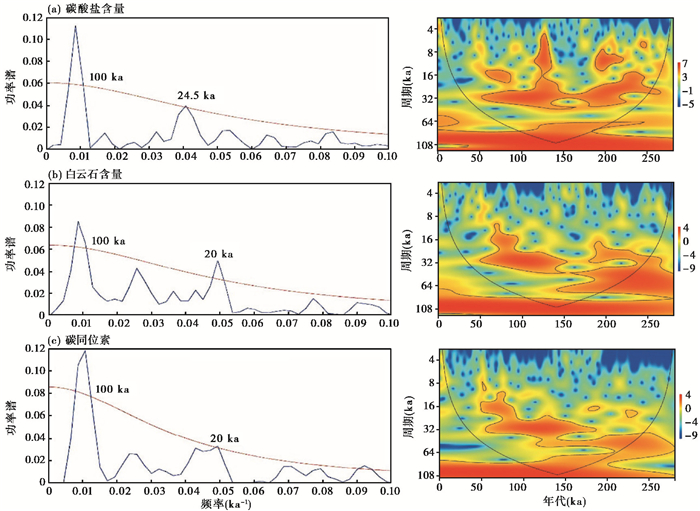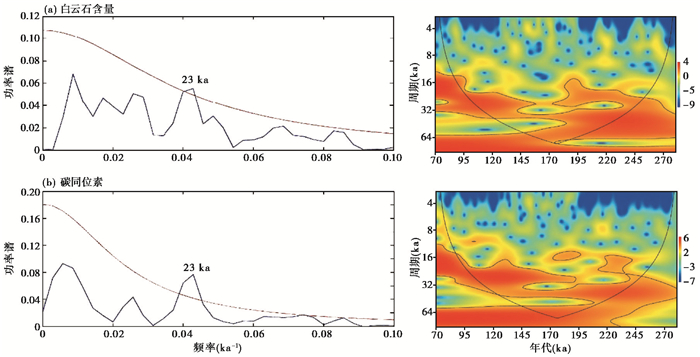东亚夏季风是亚洲季风系统的重要组成部分[1~2]。轨道尺度亚洲季风气候变化源于地球轨道参数(偏心率、地轴斜度和岁差)对日照量的调节及所引发的一系列气候系统内部过程,是理解气候变化机制的窗口[3~5]。第四纪风成黄土为研究轨道尺度的区域与全球气候变化提供了宝贵材料。东亚地区黄土-古土壤交替变化与冰期-间冰期旋回相对应,在冰期,北半球高纬冰盖的增长,西伯利亚高压增强并南移,使得东亚冬季风环流增强,向下风向输送更多的粉尘物质,形成黄土;在间冰期,夏季风带来丰富的降水促进了古土壤的发育。
然而,东亚地区的黄土与石笋记录反映的东亚夏季风轨道尺度变化和驱动机制之间还存在分歧。中更新世以来,黄土磁化率、稳定同位素、有机质、碳酸盐等与成壤和植被相关的夏季风指标时间序列含有显著的100 ka周期[6~11],表明北半球高纬冰盖的扩张与收缩、海平面的升降是控制东亚夏季风的决定性因素之一;然而,石笋氧同位素则指示了显著的约20 ka岁差旋回[12~13],证明低纬夏季太阳辐射是东亚季风的主控因素。对于黄土而言,其堆积速率和沉积后风化成壤过程对黄土记录有一定的影响[14]。已有研究表明,在末次间冰期,具有较快沉积速率的黄土高原西北部黄土剖面揭示了显著的岁差信号[6~7],如临夏塬堡剖面[15]、兰州九州台剖面[16]、靖远剖面[8]等。西宁盆地地处青藏高原东北缘,距离风尘源区较近,沉积速率快,比黄土高原中东部地区高约1~2倍,可能含有岁差周期[17~18],能够较好记录季风气候的轨道时间尺度的变化。
本文选取青藏高原东北部西宁泮子山厚层黄土钻孔样品,通过对280 ka以来的黄土磁化率、碳酸盐含量、白云石含量、全岩碳稳定同位素等代用指标分析,建立了黄土记录的青藏高原东北部轨道尺度季风气候变化时间序列。同时,利用频谱分析和小波变换技术对气候记录进行周期分析,探讨青藏高原东北缘季风气候变化的规律和驱动机制。
1 采样点自然地理和地层泮子山(36.649°N,101.844°E;海拔2728 m)钻探点地处青藏高原东北部湟水流域的西宁盆地(图 1),位于青海省互助县南部的第8阶河流阶地上[19],属于第四纪以来的风尘堆积[17~18, 20]。年平均气温4.9~7.1 ℃,年降水量在243.2~564.0 mm之间。青藏高原东北部的降水主要受东亚夏季风影响,西宁水汽后向轨迹追踪也证实其夏季降水变化的主控因子是东亚夏季风环流[21]。

|
图 1 西宁盆地钻孔点位和青藏高原东北部的黄土分布 EASM东亚夏季风;EAWM东亚冬季风;ISM印度季风(南亚季风);Westerlies西风环流 Fig. 1 Drilling site in Xining Basin and loess distribution in northeastern Tibetan Plateau. EASM, East Asian summer monsoon; EAWM, East Asian winter monsoon; ISM, Indian monsoon(South Asian monsoon) |
西宁盆地黄土露头剖面的地层和释光测年表明,该地区广泛分布着末次冰期旋回的黄土-古土壤堆积,并与黄土高原的L1和S1黄土地层对应[18~20, 22]。对泮子山(PZS)厚层黄土进行了钻探取样,钻孔选择在黄土的沉积中心部位。根据野外地层对比、土壤形态调查,PZS钻探岩芯地层有较清晰的古土壤层和黄土层,与黄土高原中部洛川和西峰黄土地层相比,沉积速率高、古土壤层发育较弱,不同地层的相对厚度变化大。S1复合古土壤层有明显的三峰,即S1由3条古土壤层组成,磁化率曲线表现出“三峰夹两谷”的形态(图 2)。

|
图 2 泮子山钻孔黄土的磁化率、粒度随深度变化曲线及洛川粒度年代序列[7]对比 (a)泮子山黄土平均粒径(μm);(b)泮子山黄土磁化率(10-8 m3/kg);(c)洛川黄土平均粒径(μm) Fig. 2 Magnetic susceptibility and grain size with depth in Panzishan and comparison with grain size time series of Luochuan. (a)Average particle size of loess in Panzishan; (b)Magnetic susceptibility of loess in Panzishan; (c)Particle size time series of loess in Luochuan[7] |
选取泮子山岩芯(PZS)上部60 m以20 cm为间隔采样,共采集样品272个,进行碳酸盐、白云石含量和碳同位素的测定和分析。
2.1 年代标尺泮子山黄土堆积的初始年代控制是根据地层结构确定,将黄土-古土壤粒度快速变化点和基于古地磁内插的洛川黄土-古地磁序列独立时间标尺[7]相对应点对比,获得泮子山黄土堆积的时间控制点;然后,基于控制点用沉积速率模式内插[23]得到独立的时间标尺(图 2),PZS岩芯上部60 m为距今280 ka以来的沉积。这一方法建立的黄土-古土壤时间标尺避免了通过轨道调谐或者与轨道调谐的冰量时间序列对比,进而建立时间标尺过程的循环论证问题。
2.2 碳酸盐和白云石含量测试黄土-古土壤样品的碳酸盐含量测试在南京大学完成。采用傅里叶红外光谱(FTIR)定量测试沉积物的白云石和方解石[24~25],仪器为Nicolet 6700傅里叶变换光谱仪漫反射仪。该仪器测试波数范围为400~4000 cm-1,每个样品扫描128次,测试时间为2~3 min。
测试流程为:1)取0.3 g样品研磨至粉状;2)放置样品在105 ℃烘箱中2h以上,去除样品中的液态水;3)将粉末样品放置在测试用的钢槽中,抖平;4)将含有样品的钢槽放入仪器测试处,调整反射率至最大,开始测试。根据每个样品的碳酸盐含量,用相对应浓度的醋酸去除方解石,尽可能保留白云石,再重复总碳酸盐含量测定的流程去测定白云石含量。需要注意的是,每次测试之前需要测定一个溴化钾(KBr)背景和3个标样,3个标样用于样品的校正,这样可以消除仪器房间环境和溴化钾粉末表面平整程度变化引起的误差。
研究发现[24],2513 cm-1波峰对总碳酸盐敏感且只对应碳酸盐矿物,但该特征峰无法区分白云石和方解石矿物;方解石和白云石有不同的红外光谱特征,白云石具有3020 cm-1、2626 cm-1和730 cm-1红外光谱吸收峰,方解石具有典型的713 cm-1和728 cm-1红外光谱吸收峰。经实验证明,2626 cm-1特征峰只响应白云石矿物,但它很容易受方解石的干扰[26]。为了去除方解石对测试白云石矿物的干扰,本研究利用弱的醋酸去除方解石而尽可能地保留白云石。当碳酸盐含量在 < 8 %、8 % ~14 %、14 % ~18 %和>18 %的时候,相应地用0.05 mol/L、0.1 mol/L、0.2 mol/L和0.5 mol/L的醋酸反应30 min即可恰好完全去除方解石而保留白云石。
建立白云石和总碳酸盐含量与相应特征峰面积的转换方程。首先,利用稀盐酸完全去除黄土中的白云石和方解石;其次,将这些去除碳酸盐的样品(基底)研磨至粉末状,用高精度电子天平称取一定质量的白云石和碳酸盐加入基底中,配制一系列不同含量的白云石与碳酸盐样品,并在玛瑙研钵中将碳酸盐矿物与基质充分混合;最后,上机测试这一系列样品的FTIR光谱,测量对应的特征峰面积,根据本实验的结果,建立白云石和总碳酸盐含量与特征峰面积的对应关系,其数学公式分别为y=0.0972x+0.217和y=0.0103x+0.0452。建立方程时,添加白云石含量范围为0~5 %,添加碳酸盐含量范围为0~30 %。
2.3 碳稳定同位素测试将样品研磨至粉末状进行上机测试。碳酸盐碳同位素测试在中国科学院南京地质古生物研究所完成,采用磷酸酸解法,将碳酸盐与磷酸在相应真空度和温度条件下进行反应、纯化,收集生成的CO2,并用稳定同位素质谱仪进行分析。所用仪器为MAT-253稳定同位素质谱仪,配备的是Kiel IV全自动碳酸盐装置,该装置采用独立酸浴室的工作原理,磷酸的存储、转移和化学反应是在高温条件下操作的。实验室控制温度为22±1 ℃,湿度为50 % ±5 %,δ13C测定值的标准偏差小于0.030 ‰ (PDB标准)。
3 结果如图 3所示,泮子山钻孔样品的碳酸盐含量变化范围为5.3 % ~22.0 %,白云石含量是0.3 % ~3.8 %,δ13C值为-0.5 ‰ ~9.0 ‰,均呈较大幅度变化。碳酸盐含量曲线和深海氧同位素曲线有较好的对应[27],深海氧同位素MIS5阶段对应古土壤层S1阶段,深海氧同位素MIS7阶段对应古土壤层S2阶段,但是MIS3阶段对应的不是很好。古土壤层的碳酸盐δ13C值比相邻黄土层的碳酸盐δ13C值更负。例如在S1阶段,在弱古土壤层碳同位素值可达-8 ‰,而在在末次冰期L1阶段碳同位素值是-1 ‰。白云石含量在S1阶段为0.3 %,而在L1阶段为3.8 %。同时,碳酸盐含量、白云石含量以及碳同位素曲线在万年尺度上总体都呈现出在黄土层中高、古土壤层中低的规律,并且3条曲线的长期变化趋势、变化幅度和波动一致。

|
图 3 过去280 ka以来泮子山黄土记录及深海氧同位素[27]、石笋δ18O[12]对比图 (a)泮子山黄土稳定碳同位素(‰);(b)泮子山黄土平均粒度变化(μm);(c)泮子山黄土碳酸盐含量(%);(d)泮子山黄土白云石含量(%);(e)泮子山黄土磁化率(10-3 m3/kg);(f)LR04深海氧同位素记录[27](‰);(g)西峰剖面生物微钙体Sr/Ca比值[28](mmol/mol);(h)三宝洞石笋δ18O记录[12](‰);(i)7月北纬30°太阳辐射[29](W/m2) Fig. 3 Panzishan loess records since 280 ka and comparison with deep sea oxygen isotope, stalagmite δ18O. (a)Stable carbon isotopic composition of Panzishan loess(‰); (b)Mean grain size record of Panzishan loess(μm); (c)Carbonate content of Panzishan loess(%); (d)Dolomite content of Panzishan loess(%); (e)Magnetic susceptibility of Panzishan loess(10-3 m3/kg); (f)LR04 benthic oxygen isotopic record[27](‰); (g)Microcodium Sr/Ca from Xifeng section[28](mmol/mol); (h)Speleothem δ18O record from Sanbao cave[12](‰); (i)July solar radiation at 30°N[29](W/m2) |
对泮子山黄土的白云石含量和碳同位素时间序列的频谱分析和小波分析表明,280~0 ka具有显著的100 ka和23 ka周期(图 4)。考虑到钻孔顶部黄土堆积部分缺失,如果只计算280~70 ka期间周期,只检测到显著的23 ka岁差周期(图 5)。

|
图 4 280~0 ka泮子山黄土代用指标时间序列频谱与小波分析结果 (a)碳酸盐含量的频谱和小波分析结果;(b)白云石含量的频谱和小波分析结果;(c)碳同位素的频谱和小波分析结果 Fig. 4 Spectral and wavelet analysis results of Panzishan loess proxies time series since the past 280 ka. (a)Spectral and wavelet analysis results of carbonate content; (b)Spectral and wavelet analysis results of dolomite content; (c)Spectral and wavelet analysis results of Stable carbon isotope |

|
图 5 280~70 ka泮子山钻孔黄土代用指标时间序列频谱与小波分析结果 (a)白云石含量的频谱和小波分析结果;(b)碳同位素的频谱和小波分析结果 Fig. 5 Spectral and wavelet analysis results of Panzishan loess proxies time series from 280 ka to 70 ka. (a) Spectral and wavelet analysis results of dolomite content; (b)Spectral and wavelet analysis results of stable carbon isotope |
黄土中碳酸盐含量的周期性变化反映气候的干湿变化[30]。碳酸盐在黄土中的淋失程度取决于当地降水的多少,主要反映夏季风降水的变化,因此,黄土的碳酸盐含量是东亚季风环流强度的指示,是夏季风的良好代用指标[8, 22]。当黄土中碳酸盐含量初始量为恒定时,其含量变化主要受沉积后过程影响,即主要受控于降水、蒸发、土壤溶液和温度变化共同影响的成壤作用[31~33]。
土壤溶液受土壤的呼吸作用及降水的影响,而土壤呼吸作用又与植被覆盖度、类型和微生物作用有关[31~32]。研究已证明,黄土高原现代表土的植被覆盖度及类型主要受季风降水变化控制[31];西宁现代植被以C3为主,与降水量关系密切[34~35]。此外,西宁泮子山位于青藏高原东北部,海拔较高且气候干燥,微生物作用较弱,对土壤溶液的影响不大。
实验数据显示,在恒定的CO2浓度下,随着温度的升高,碳酸盐溶解度逐渐减小[36]。同时,根据使用PHREEQC软件进行的地球化学模拟结果,白云石也呈现相同的规律,在CO2浓度(1000 ppm)恒定的环境下,当温度从15 ℃上升到20 ℃时,白云石的溶解度从102 mg/L下降至91 mg/L[25]。冰期-间冰期的温度变化幅度为5~11 ℃[37~39],间冰期温度上升,碳酸盐溶解度降低,其含量应该增加,但实验结果显示,碳酸盐及白云石含量均显著下降(图 3),据此推测温度不是泮子山黄土碳酸盐含量变化的主导因素。
黄土中白云石仅来自于源区[40~41],其抗风化能力强于方解石,在地表环境中一般比方解石保存的时间长,风化成壤作用和夏季风降水的淋滤作用对其含量影响较小,很难经过重结晶作用形成次生白云石。碎屑白云石的消耗具有单向性,因此可以认为白云石的耗尽就是碎屑碳酸盐的完全溶解。研究表明,白云石和方解石的存在与否及淋失深度与季风降水相关,根据降水量范围分为4个阶段[25]:第一阶段,白云石和方解石共存;第二阶段,方解石消失而白云石存在;第三阶段,方解石和白云石均消失但没有向下层淋溶;第四阶段,方解石和白云石均消失且向下层淋溶。当白云石和方解石共同存在时,白云石含量与年平均降水量呈现很好的负相关关系,表明其含量可以作为降水量多少的指示,同时也是夏季风的指标[25]。
4.2 黄土碳酸盐碳同位素对季风气候变化的响应碳酸盐碳同位素(δ13CIC)和磁化率相比在冰期有更明显的变幅和变率。碳酸盐碳同位素已被用作一个可靠的古环境代用指标,尤其是指示古植被中的C3/C4比值[42~43]。在黄土高原西北部,δ13CIC被用于指示夏季风强度变化和植被类型,与年均降水量呈负相关[44]。但是,在干旱区黄土中同时存在着碎屑和成土成因碳酸盐,因此,对于全岩碳酸盐碳同位素的古气候意义仍然需要深入分析。
研究表明,黄土总碳酸盐的碳同位素组成代表了原生碳酸盐和次生碳酸盐的混合信号[45]。因此,δ13CIC的值受到两个因素的影响:碎屑碳酸盐的碳同位素(δ13CDC)和成土碳酸盐的碳同位素(δ13CPC)。碎屑碳酸盐和成土碳酸盐的比例,用公式[9]表示如下:

|
(1) |
公式(1)中,f代表的是成土碳酸盐的比例。
δ13CDC代表的是碎屑碳酸盐碳同位素值,来自亚洲内陆粉尘源区的碎屑碳酸盐的碳同位素变化范围在-0.9 ‰ ~0.7 ‰之间,相对稳定[9]。δ13CPC不是一个稳定的端元,并且δ13CPC贡献了δ13CIC在冰期间冰期变幅的三分之二[44],所以,δ13CIC的变化主要反映了成土碳酸盐的变化。
成土碳酸盐主要是由土壤溶液中的CO2系统的平衡发生改变而沉淀形成[46]。因此,这种次生成因碳酸盐的稳定同位素组成继承了土壤溶液中CO2-H2O系统的同位素性质[47]。土壤成土碳酸盐的δ13CPC受控于土壤CO2的δ13C,而土壤CO2又是呼吸作用产生的CO2与大气CO2混合的结果,其值受到土壤呼吸作用的影响。土壤呼吸作用和成土过程在季风区其主要发生在夏季[48],因此成土碳酸盐的碳同位素记录了过去夏季风信息。成土碳酸盐常用来重建过去的CO2浓度或者C4植被覆盖率[43],同样的也对土壤呼吸通量敏感[49]。成土碳酸盐δ13CPC与土壤CO2的δ13CS的相关公式[50]如下:

|
(2) |
δ13CS为土壤中总的CO2碳同位素值,T为摄氏温度,根据公式(2)可知,土壤碳酸盐δ13CPC主要与土壤CO2的δ13CS和温度有关,已知δ13CPC的范围,因此要评估温度对δ13CS的影响。根据图 3中MIS5阶段数据可知,δ13CPC的范围为-4 ‰到-9 ‰,冰期-间冰期地表温度变化幅度为5~11 ℃[37~39],计算得到δ13CS变化范围是3.0 ‰ ~4.6 ‰,几乎可以忽略不计,表明温度对泮子山δ13C影响不大。因此δ13CPC可以由δ13CS来计算表示,其转换公式[43, 51]如下所示:

|
(3) |

|
(4) |
公式(3)中,δ13CS、δ13Ca、δ13Co分别是土壤CO2、大气CO2、植物和土壤有机质呼吸CO2的碳同位素值,Ca是大气CO2浓度、CS是土壤CO2浓度。公式(4)中,CS是土壤呼吸通量ϕs的函数,Ds是CO2在土壤中的扩散系数,

南极冰芯的结果显示,在过去280 ka期间大气CO2浓度为200~280 ppm[55],同时,大气CO2的δ 13Ca相对恒定[56]。δ13Co受C4/C3影响,现代西宁植被以短花针茅(Stipa breviflora Griseb.)、长芒草(Stipa bungeana Trin.)草被为主,属于C3植被[34],因此,可以假定西宁在280 ka以来以C3植被为主。综上分析,δ13CPC主要受土壤呼吸通量、碳酸盐在土壤中形成深度的影响。分析PZS岩芯的数据,在冰期δ13CPC更偏正,说明δ13CPC更偏向大气二氧化碳同位素端元,土壤二氧化碳浓度对δ13CPC控制减弱,说明土壤呼吸通量减少即植被量减少,或者碳酸盐在土壤形成深度的减少,最终原因应该是降水量的减少;在间冰期δ13CPC更偏负,说明δ13CPC更偏向土壤呼吸二氧化碳同位素端元,土壤二氧化碳浓度对δ13CPC控制加强,说明土壤呼吸通量增加即植被量增加,或者土壤淋溶深度增加,间冰期时沉积物中的碳酸盐向下淋溶,其淀积层多位于下伏的黄土中,最终可能原因是降水量的增加。这也是黄土高原西部较为干冷地区土壤碳同位素分馏模式的机制[57]。降水量变化控制了土壤碳酸盐δ13C值变化,δ13CPC与降水成负相关关系,可以作为季风指标。
同时,碳酸盐含量、白云石含量、δ13C值的偏负阶段与磁化率的高值(成壤作用强、降水增加)和粒度变细吻合,进一步证明了其主要受控于降水的变化。3条曲线之间细微的差别可能是由于代用指标对季风降水相应的敏感度决定的。三者含量与地层对应良好,表明其指示了轨道时间尺度季风气候变化。
4.3 岁差主控的东亚季风降水演化西宁泮子山黄土与黄土高原中部黄土记录的东亚季风气候对比(图 2)表明,在末次冰期黄土高原中部黄土堆积中发育了一层弱的古土壤(L1SS1,相当于MIS3),表现为粒度值的减小;而在青藏高原季风区的泮子山钻孔没有较好的古土壤发育,表现在粒度曲线上是多次的波动[18];此外,西宁地区大墩岭钻孔的黄土-古土壤序列的磁化率值在MIS3阶段有明显的峰值[20]且有一层弱古土壤发育,表明西宁泮子山钻孔顶部可能存在阶段性缺失。泮子山剖面位于青海省互助县南部的第8阶河流阶地上[58],是该地区较高黄土堆积之一,相对于在湟水较低阶地的大墩岭黄土堆积,可能既是沉积区又受到一定的风蚀作用,因而造成了泮子山钻孔顶部黄土阶段性缺失。
为了探讨青藏高原东北缘季风降水的影响机制,我们对泮子山黄土的白云石含量和碳同位素时间序列进行频谱分析和小波分析,结果显示,280~0 ka具有显著的100 ka和23 ka周期(图 4)。同时考虑到钻孔顶部部分黄土堆积缺失,如果计算280~70 ka,只能检测到显著的23 ka岁差周期(图 5)。280~70 ka期间缺少100 ka周期的现象,推测可能是因为该段时间跨度(210 ka)仅为100 ka周期的两倍长,时间序列短,无法明确分析出100 ka周期;然而,280 ka以来泮子山黄土钻孔的代用指标记录(图 3)显示,其具有明显的冰期-间冰期变化,并且西宁泮子山钻孔的第四纪黄土磁化率记录与洛川黄土磁化率记录有着良好的对应关系[59],可以推断研究序列具有100 ka的周期;但是,23 ka的岁差周期在泮子山黄土记录中起主导作用。
以往的黄土记录揭示100 ka冰量周期远远强于20 ka岁差周期,我们认为主要有两点原因。其一,间冰期时期黄土的沉积速率较低,成壤作用会改造下伏沉积的古环境代用指标[60~62],导致信号均一化,尤其是黄土高原东南部地区,像西峰、洛川、灵台、渭南[7, 63]等黄土剖面S1古土壤层厚度仅仅为3 m左右,体现为一层红褐色古土壤层;而在沉积速率较快的邙山、西宁、草滩、沙沟等剖面S1古土壤层厚度接近10 m,发育了3层间层古土壤[20]。其二,沉积速率在冰期较快,然而不同指标对季风降水的响应是非线性的。同样在夏季太阳辐射峰值期,磁化率等与成壤有关的指标往往振幅较小,而像单体氢同位素以及生物微钙体元素比值等[28, 64]与季风降水相关性强的指标变化幅度较大,显示出岁差周期波动(图 3g)。
西宁盆地黄土沉积速率快,气候响应敏感,白云石含量与δ13C值显示在冰期旋回的变化中叠加了更高频率的岁差信号,与北半球低纬太阳辐射变化吻合较好,其高值与太阳辐射高值对应(图 3),表明约20 ka的岁差周期在西宁盆地的黄土记录中起主导作用,岁差驱动的低纬太阳辐射变化是青藏高原东北缘季风降水变化的主控因素。另外,显著的100 ka周期的黄土和古土壤旋回,说明高纬冰量对青藏高原东北缘季风降水的影响。
5 结论本文选择青藏高原东北部西宁泮子山黄土堆积作为研究对象,通过分析其磁化率、碳酸盐含量、白云石含量、碳酸盐碳同位素等气候代用指标,探讨青藏高原东北部季风气候的变化规律和控制因素。
研究表明,西宁泮子山黄土-古土壤序列的碳酸盐和白云石含量与夏季风降水呈负相关关系,是反映夏季风降水的敏感指标。碳酸盐含量、白云石含量降低指示降水量增大,气候暖湿,夏季风增强;反之,指示降水量减少,气候干冷,冬季风增强。应用MAT-253质谱仪测量了黄土碳酸盐的碳同位素组成变化。结果表明,δ13CIC的变化主要受成土碳酸盐碳同位素变化影响,与土壤呼吸通量及碳酸盐在土壤中的深度有关,δ13CIC偏负指示降水量增加,δ13CIC偏正指示降水量减少。
利用频谱和小波分析技术对季风气候变化时间序列进行分析,结果显示,最近280 ka以来,东亚夏季风变化具有轨道尺度周期的规律,并与高纬地区冰量和北半球温度变化有一定的联系。西宁黄土记录具有显著23 ka的岁差周期。频域的证据显示,岁差调制的低纬地区太阳辐射变化是驱动青藏高原东北部轨道尺度季风降水变化的主导因素,高纬地区冰量和温度变化对轨道尺度的季风变化也有一定的影响。
致谢: 感谢季峻峰教授、孟先强、王翰林、徐蕴韵在实验室测试中给予的帮助。
| [1] |
Wang B, Liu J, Kim H-J, et al. Recent change of the global monsoon precipitation(1979-2008)[J]. Climate Dynamics, 2012, 39(5): 1123-1135. DOI:10.1007/s00382-011-1266-z |
| [2] |
Wang Pinxian, Wang Bin, Cheng Hai, et al. The global monsoon across time scales:Mechanisms and outstanding issues[J]. Earth-Science Reviews, 2017, 174: 84-121. DOI:10.1016/j.earscirev.2017.07.006 |
| [3] |
丁仲礼. 米兰科维奇冰期旋回理论:挑战与机遇[J]. 第四纪研究, 2006, 26(5): 710-717. Ding Zhongli. The Milankovitch Theory of Pleistocene glacial cycles:Challenges and chances[J]. Quaternary Sciences, 2006, 26(5): 710-717. |
| [4] |
程海, 张海伟, 赵景耀, 等. 中国石笋古气候研究的回顾与展望[J]. 中国科学:地球科学, 2019, 62(10): 1565-1589. Cheng Hai, Zhang Haiwei, Zhao Jingyao, et al. Chinese stalagmite paleoclimate researches:A review and perspective[J]. Science China:Earth Sciences, 2019, 62(10): 1489-1513. |
| [5] |
鹿化煜, 王珧, 郝青振, 等.第四纪轨道尺度亚洲季风变化[M]//郭正堂.气候变化及人类的演化与适应.北京: 2021. Lu Huayu, Wang Yao, Hao Qingzhen, et al. Quaternary orbit-scale Asian monsoon changes[M]//Guo Zhengtang. Climate Change and Human Evolution and Adaptation. Beijing: 2021. |
| [6] |
Lu Huayu, Zhang Fuqing, Liu Xiaodong. Patterns and frequencies of the East Asian winter monsoon variations during the past million years revealed by wavelet and spectral analyses[J]. Global and Planetary Change, 2003, 35(1-2): 67-74. DOI:10.1016/S0921-8181(02)00136-4 |
| [7] |
Lu Huayu, Zhang Fuqing, Liu Xiaodong, et al. Periodicities of palaeoclimatic variations recorded by loess-paleosol sequences in China[J]. Quaternary Science Reviews, 2004, 23(18-19): 1891-1900. DOI:10.1016/j.quascirev.2004.06.005 |
| [8] |
Sun Youbin, Yin Qiuzhen, Crucifix Michel, et al. Diverse manifestations of the mid-Pleistocene climate transition[J]. Nature Communications, 2019, 10(1): 352-363. DOI:10.1038/s41467-018-08257-9 |
| [9] |
Sun Youbin, Kutzbach John, An Zhisheng, et al. Astronomical and glacial forcing of East Asian summer monsoon variability[J]. Quaternary Science Reviews, 2015, 115: 132-142. DOI:10.1016/j.quascirev.2015.03.009 |
| [10] |
Guo Zhengtang, Pierre Biscaye, Wei Lanying, et al. Summer monsoon variations over the last 1.2 Ma from the weathering of loess-soil sequences in China[J]. Geophysical Research Letter, 2000, 27: 1751-1754. DOI:10.1029/1999GL008419 |
| [11] |
Guo Zhengtang, Zhou Xin, Wu Haibin. Glacial-interglacial water cycle, global monsoon and atmospheric methane changes[J]. Climate Dynamics, 2012, 39: 1073-1092. DOI:10.1007/s00382-011-1147-5 |
| [12] |
Cheng Hai, Edwards R Lawrence, Sinha Ashish, et al. The Asian monsoon over the past 640, 000 years and ice age terminations[J]. Nature, 2016, 534(7609): 640-646. DOI:10.1038/nature18591 |
| [13] |
Wang Yongjin, Cheng Hai, Edwards R Lawrence, et al. Millennial-and orbital-scale changes in the East Asian monsoon over the past 224, 000 years[J]. Nature, 2008, 451(7182): 1090-1093. DOI:10.1038/nature06692 |
| [14] |
An Zhisheng, Wu Guoxiong, Li Jianping, et al. Global monsoon dynamics and climate change[J]. Annual Review of Earth and Planetary Sciences, 2015, 43: 29-77. DOI:10.1146/annurev-earth-060313-054623 |
| [15] |
陈发虎, 饶志国, 张家武, 等. 陇西黄土高原末次冰期有机碳同位素变化及其意义[J]. 科学通报, 2006, 51(11): 1310-1317. Chen Fahu, Rao Zhiguo, Zhang Jiawu, et al. Variations of organic carbon isotopic composition and its environmental significance during the last glacial on western Chinese Loess Plateau[J]. Chinese Science Bulletin, 2006, 51(13): 1593-1602. |
| [16] |
Liu Qingsong, Banerjee Subir K, Jackson Michael J, et al. Inter-profile correlation of the Chinese loess/paleosol sequences during Marine Oxygen Isotope Stage 5 and indications of pedogenesis[J]. Quaternary Science Reviews, 2005, 24(1-2): 195-210. DOI:10.1016/j.quascirev.2004.07.021 |
| [17] |
Lu Huayu, Wang Xiaoyong, Ma Haizhou, et al. The Plateau monsoon variation during the past 130 kyr revealed by loess deposit at northeast Qinghai Tibet(China)[J]. Global and Planetary Change, 2004, 41(3-4): 207-214. DOI:10.1016/j.gloplacha.2004.01.006 |
| [18] |
鹿化煜, 马海洲, 谭红兵, 等. 西宁黄土堆积记录的最近13万年高原季风气候变化[J]. 第四纪研究, 2001, 21(5): 416-426. Lu Huayu, Ma Haizhou, Tan Hongbing, et al. Plateau monsoon climate change recorded by Xining loess accumulation in the latest 130, 000 years[J]. Quaternary Sciences, 2001, 21(5): 416-426. |
| [19] |
Wang Xianyan, Lu Huayu, Vandenberghe Jef, et al. Late Miocene uplift of the NE Tibetan Plateau inferred from basin filling, planation and fluvial terraces in the Huang Shui catchment[J]. Global and Planetary Change, 2012, 88-89: 10-19. DOI:10.1016/j.gloplacha.2012.02.009 |
| [20] |
鹿化煜, 王先彦, 孙雪峰, 等. 钻探揭示的青藏高原东北部黄土地层与第四纪气候变化[J]. 第四纪研究, 2007, 27(2): 230-241. Lu Huayu, Wang Xianyan, Sun Xuefeng, et al. Loess stratigraphy and palaeoclimate changes during Quaternary in northeastern Tibetan Plateau revealed by loess core[J]. Quaternary Sciences, 2007, 27(2): 230-241. |
| [21] |
Thomas Elizabeth K, Huang Yongsong, Clemens Steven C, et al. Changes in dominant moisture sources and the consequences for hydroclimate on the northeastern Tibetan Plateau during the past 32 kyr[J]. Quaternary Science Reviews, 2016, 131: 157-167. DOI:10.1016/j.quascirev.2015.11.003 |
| [22] |
Chen Fahu, Bloemendal Jan W, Wang Jianming, et al. High-resolution multi-proxy climate records from Chinese loess:Evidence for rapid climatic changes over the last 75 kyr[J]. Palaeogeography, Palaeoclimatology, Palaeoecology, 1997, 130(1-4): 323-335. DOI:10.1016/S0031-0182(96)00149-6 |
| [23] |
Porter Stephen C, An Zhisheng. Correlation between climate events in the North Atlantic and China during the last glaciation[J]. Nature, 1995, 375(6529): 305-308. DOI:10.1038/375305a0 |
| [24] |
Ji Junfeng, Ge Yun, Balsam William, et al. Rapid identification of dolomite using a Fourier Transform Infrared Spectrophotometer(FTIR):A fast method for identifying Heinrich events in IODP Site U1308[J]. Marine Geology, 2009, 258(1-4): 60-68. DOI:10.1016/j.margeo.2008.11.007 |
| [25] |
Meng Xianqiang, Liu Lianwen, Balsam William, et al. Dolomite abundance in Chinese loess deposits:A new proxy of monsoon precipitation intensity[J]. Geophysical Research Letters, 2015, 42(23): 10391-10398. |
| [26] |
He Tong, Chen Yang, Balsam William, et al. Distribution and origin of protodolomite from the Late Miocene-Pliocene Red Clay Formation, Chinese Loess Plateau[J]. Geochemistry, Geophysics, Geosystems, 2012, 13(6): Q06004. |
| [27] |
Lisiecki Lorraine E, Raymo Maureen E. A Pliocene-Pleistocene stack of 57 globally distributed benthic δ18O records[J]. Palaeogeography, 2005, 20(1): PA1003. |
| [28] |
Li Tao, Liu Fei, Abels Hemmo A, et al. Continued obliquity pacing of East Asian summer precipitation after the mid-Pleistocene transition[J]. Earth and Planetary Science Letters, 2017, 457: 181-190. DOI:10.1016/j.epsl.2016.09.045 |
| [29] |
Berger Andre, Loutre Marie-Frane. Insolation values for the climate of the last 10 million years[J]. Quaternary Science Reviewes, 1991, 10(4): 297-317. DOI:10.1016/0277-3791(91)90033-Q |
| [30] |
席建建, 符超峰, 孟媛媛, 等. 青藏高原东北缘尖扎盆地碳酸盐含量及其古环境意义[J]. 第四纪研究, 2018, 38(1): 107-117. Xi Jianjian, Fu Chaofeng, Meng Yuanyuan, et al. Carbonate content of Jianzha Basin in northeastern margin of the Tibetan Plateau and paleoclimatic significance[J]. Quaternary Sciences, 2018, 38(1): 107-117. |
| [31] |
Liu Weiguo, Huang Yongsong, An Zhisheng, et al. Summer monsoon intensity controls C4/C3 plant abundance during the last 35 ka in the Chinese Loess Plateau:Carbon isotope evidence from bulk organic matter and individual leaf waxes[J]. Palaeogeography, Palaeoclimatology, Palaeoecology, 2005, 220(3-4): 243-254. DOI:10.1016/j.palaeo.2005.01.001 |
| [32] |
Peterse Francien, Martínez-García Alfredo, Zhou Bin, et al. Molecular records of continental air temperature and monsoon precipitation variability in East Asia spanning the past 130, 000 years[J]. Quaternary Science Reviews, 2014, 83: 76-82. DOI:10.1016/j.quascirev.2013.11.001 |
| [33] |
Xin Zhongbao, Xu Jiongxin, Zheng Wei. Spatiotemporal variations of vegetation cover on the Chinese Loess Plateau(1981-2006):Impacts of climate changes and human activities[J]. Science in China(Series D), 2008, 51(1): 67-78. DOI:10.1007/s11430-007-0137-2 |
| [34] |
张新时. 中国植被及其地理格局——中华人民共和国植被图集(1︰100万)说明书(下卷)[M]. 北京: 地质出版社, 2007. Zhang Xinshi. Vegetation of China and Its Geography, Atlas of vegetaion China(1︰1000000)(Ⅱ)[M]. Beijing: Geoloegical Publishing House, 2007. |
| [35] |
An Zhisheng, Huang Yongsong, Liu Weiguo, et al. Multiple expansions of C4 plant biomass in East Asia since 7 Ma coupled with strengthened monsoon circulation[J]. Geology, 2005, 33(9): 705-708. DOI:10.1130/G21423.1 |
| [36] |
Plummer L Niel, Busenberg Eurybiades. The solubilities of calcite, aragonite and vaterite in CO2-H2O solutions between 0 and 90 ℃, and an evaluation of the aqueous model for the system CaCO3-CO2-H2O[J]. Geochimica et Cosmochimica Acta, 1982, 46(6): 1011-1040. DOI:10.1016/0016-7037(82)90056-4 |
| [37] |
俞凯峰, 鹿化煜, Lehmkuhl Frank, 等. 末次盛冰期和全新世大暖期中国北方沙地古气候定量重建初探[J]. 第四纪研究, 2013, 33(2): 293-302. Yu Kaifeng, Lu Huayu, Lehmkuhl Frank, et al. A preliminary quantitative paleoclimate reconstruction of the dune fields of Northern China during the Last Glacial Maximum and Holocene Optimum[J]. Quaternary Sciences, 2013, 33(2): 293-302. |
| [38] |
Lu Hongxuan, Liu Weiguo, Yang Hong, et al. 800-kyr land temperature variations modulated by vegetation changes on Chinese Loess Plateau[J]. Nature Communications, 2019, 10(1): 1958-1967. DOI:10.1038/s41467-019-09978-1 |
| [39] |
Peterse Francien, Prins Maarten A, Beets Christiaan J, et al. Decoupled warming and monsoon precipitation in East Asia over the last deglaciation[J]. Earth and Planetary Science Letters, 2011, 301(1-2): 256-264. DOI:10.1016/j.epsl.2010.11.010 |
| [40] |
Jeong Gi Young, Hillier Stephen, Kemp Rob A. Quantitative bulk and single-particle mineralogy of a thick Chinese loess-paleosol section:Implications for loess provenance and weathering[J]. Quaternary Science Reviews, 2008, 27(11-12): 1271-1287. DOI:10.1016/j.quascirev.2008.02.006 |
| [41] |
Li Gaojun, Chen Jun, Chen Yang, et al. Dolomite as a tracer for the source regions of Asian dust[J]. Journal of Geophysical Research:Atmospheres, 2007, 112(D17): D17201. DOI:10.1029/2007JD008676 |
| [42] |
Cerling Thure E. The stable isotopic composition of modern soil carbonate and its relationship to climate[J]. Earth and Planetary Science Letters, 1984, 71(2): 229-240. |
| [43] |
Cerling Thure E, Harris John M. Carbon isotope fractionation between diet and bioapatite in ungulate mammals and implications for ecological and paleoecological studies[J]. Oecologia, 1999, 120(3): 347-363. DOI:10.1007/s004420050868 |
| [44] |
Liu Weiguo, Yang Hong, Sun Youbin, et al. δ13C Values of loess total carbonate:A sensitive proxy for Asian summer monsoon in arid northwestern margin of the Chinese Loess Plateau[J]. Chemical Geology, 2011, 284(3-4): 317-322. DOI:10.1016/j.chemgeo.2011.03.011 |
| [45] |
Ning Youfeng, Liu Weiguo, An Zhisheng. Variation of soil Δδ13C values in Xifeng loess-paleosol sequence and its paleoenvironmental implication[J]. Chinese Science Bulletin, 2006, 51(11): 1350-1354. DOI:10.1007/s11434-006-1350-7 |
| [46] |
Morse John W, Mackenzie Fred T. Geochemistry of Sedimentary Carbonates[M]. Amsterdam: Elsevier, 1990: 1-20.
|
| [47] |
盛雪芬, 陈骏, 杨杰东, 等. 不同粒级黄土-古土壤中碳酸盐碳氧稳定同位素组成及其古环境意义[J]. 地球化学, 2002, 31(2): 105-112. Sheng Xuefen, Chen Jun, Yang Jiedong, et al. Carbon and oxygen isotopic composition of carbonate in different grain size fractions from loess-paleosol sequences, China[J]. Geochimica, 2002, 31(2): 105-112. |
| [48] |
Yang Shiling, Ding Zhongli, Wang Xu, et al. Negative δ18O-δ13C relationship of pedogenic carbonate from Northern China indicates a strong response of C3/C4 biomass to the seasonality of Asian monsoon precipitation[J]. Palaeogeography, Palaeoclimatology, Palaeoecology, 2012, 317-318: 32-40. DOI:10.1016/j.palaeo.2011.12.007 |
| [49] |
Quade Jay, Cerling Thure E, Bowman John R. Systematic variations in the carbon and oxygen isotopic composition of pedogenic carbonate along elevation transects in the southern Great Basin, United States[J]. Geological Society of America Bulletin, 1989, 101(4): 464-475. DOI:10.1130/0016-7606(1989)101<0464:SVITCA>2.3.CO;2 |
| [50] |
Breecker D O, Sharp Z D, McFadden L D. Seasonal bias in the formation and stable isotopic composition of pedogenic carbonate in modern soils from central New Mexico, USA[J]. Geological Society of America Bulletin, 2009, 121(3-4): 630-640. DOI:10.1130/B26413.1 |
| [51] |
Caves Jeremy K, Moragne Danielle Y, Ibarra Daniel E, et al. The Neogene de-greening of Central Asia[J]. Geology, 2016, 44(11): 887-890. DOI:10.1130/G38267.1 |
| [52] |
Bond-Lamberty B, Thomson A H. A global database of soil respiration data[J]. Biogeosciences, 2010, 7(6): 1915-1926. DOI:10.5194/bg-7-1915-2010 |
| [53] |
Kohn Matthew J. Carbon isotope compositions of terrestrial C3 plants as indicators of(paleo)ecology and(paleo)climate[J]. Proceedings of the National Academy of Sciences of the United States of America, 2010, 107(46): 19691-19695. DOI:10.1073/pnas.1004933107 |
| [54] |
Retallack Gregory J. Pedogenic carbonate proxies for amount and seasonality of precipitation in paleosols[J]. Geology, 2005, 33(4): 333-336. DOI:10.1130/G21263.1 |
| [55] |
Ahn Jinho, Brook Edward J. Atmospheric CO2 and climate on millennial time scales during the last glacial period[J]. Science, 2008, 322(5898): 83-85. DOI:10.1126/science.1160832 |
| [56] |
Eggleston S, Schmitt J, Bereiter B, et al. Evolution of the stable carbon isotope composition of atmospheric CO2 over the last glacial cycle[J]. Paleoceanography, 2016, 31(3): 434-452. DOI:10.1002/2015PA002874 |
| [57] |
饶志国, 陈发虎, 曹洁, 等. 黄土高原西部地区末次冰期和全新世有机碳同位素变化与C3/C4植被类型转换研究[J]. 第四纪研究, 2005, 25(1): 107-114. Rao Zhiguo, Chen Fahu, Cao Jie, et al. Variation of soil organic carbon isotope and C3/C4 vegetation type transition in the western Loess Plateau during the last glacial and Holocene periods[J]. Quaternary Sciences, 2005, 25(1): 107-114. |
| [58] |
鹿化煜, 安芷生, 王晓勇, 等. 最近14 Ma青藏高原东北缘阶段性隆升的地貌证据[J]. 中国科学(D辑), 2004, 47(9): 855-864. Lu Huayu, An Zhisheng, Wang Xiaoyong, et al. Geomorphologic evidence of phased uplift of the northeastern Qinghai-Tibet Plateau since 14 million years ago[J]. Science in China(Series D), 2004, 47(9): 822-833. |
| [59] |
Lu Huayu, Wang Xianyan, Wang Xiaoyong, et al. Palaeoclimatic changes in Northeastern Qinghai-Tibetan Plateau revealed by magnetostratigraphy and magnetic susceptibility analysis of thick loess deposits[J]. Netherlands Journal of Geosciences, 2012, 91(1-2): 189-198. DOI:10.1017/S001677460000158X |
| [60] |
Feng Zhaodong, Wang Haibin, Olson C G. Pedogenic factors affecting magnetic susceptibility of the last interglacial palaeosol S1 in the Chinese Loess Plateau[J]. Earth Surface Processes and Landforms, 2004, 29(11): 1389-1402. DOI:10.1002/esp.1110 |
| [61] |
Feng Zhaodong, Wang Haibin. Geographic variations in particle size distribution of the last interglacial pedocomplex S1 across the Chinese Loess Plateau:Their chronological and pedogenic implications[J]. Catena, 2006, 65(3): 315-328. DOI:10.1016/j.catena.2006.01.002 |
| [62] |
Ma Long, Li Ying, Liu Xingxing, et al. Registration of precession signal in the last interglacial paleosol(S1) on the Chinese Loess Plateau[J]. Geochemistry, Geophysics, Geosystems, 2017, 18(11): 3964-3975. DOI:10.1002/2017GC006964 |
| [63] |
Lu Huayu, Sun Donghuai. Pathways of dust input to the Chinese Loess Plateau during the last glacial and interglacial periods[J]. Catena, 2000, 40(3): 251-261. DOI:10.1016/S0341-8162(00)00090-4 |
| [64] |
Wang Zheng, An Zhisheng, Liu Zhonghui, et al. Hydroclimatic variability in loess δDwax records from the central Chinese Loess Plateau over the past 250 ka[J]. Journal of Asian Earth Sciences, 2018, 155: 49-57. DOI:10.1016/j.jseaes.2017.11.008 |
Abstract
East Asian summer monsoon(EASM) is an important component of Earth's climate system, which significantly influences the production and life of billion-plus populations over East Asia. East Asian monsoon variability and associated forcing mechanisms are the focus and frontier of Earth system science. Orbital timescale variability and forcing mechanisms of the EASM from paleoclimatic reconstructions still remain elusive. Previous studies revealed that precession-band variance is not the dominated frequency in loess records, while eccentricity-band is missing in high-resolution speleothem records. Whether loess deposit can record monsoon variability on a precession timescale largely depends on sedimentation rate and post-depositional processes that can attenuate the variability of the loess proxies. In this study, we chose the upper 60 m of the loess core located at Panzishan(PZS) (36.649°N, 101.844°E; 2728 m a.s.l.), Xining Basin in the northeastern Qinghai-Tibetan Plateau, where the dust sedimentation rate is high. A total of 272 samples were taken at an interval of 20 cm in this section. The depth-age model was constructed based on linear interpolations, and detail correlations between the grain size variations of the loess and the grain size time series of Luochuan. We present the grain size distribution, magnetic susceptibility, carbonate content, dolomite content and δ13C of carbonate of the loess-paleosol samples to reconstruct the EASM changes at Xining. The carbonate content and dolomite content are negatively related to rainfall. The δ13C of loess carbonate is related to soil respiration flux which was determined by the EASM intensity, therefore it is an ideal proxy of EASM in the northeastern Qinghai-Tibetan Plateau. Compared with magnetic susceptibility, carbonate content, dolomite content and δ13C can detect the same order of wet events during the last 280 ka. Our results show that these proxy records exhibit significant orbital timescale fluctuations, and linking the EASM with the high-latitude ice sheets in Northern Hemisphere and temperature. In addition, our spectral and wavelet transfers of the proxies time series detect a distinct 23 ka cycle, corresponding well with the precision cycle and frequency of speleothem δ18O. These results suggest that climate change in the northeastern Qinghai-Tibetan Plateau is not simply a response to high-latitude ice sheets and Northern Hemispaere temperature; low-latitude solar radiation changes driven by precession is also playing an important role in driving EASM precipitation changes in the northeastern Qinghai-Tibetan Plateau. 2020, Vol.40
2020, Vol.40

